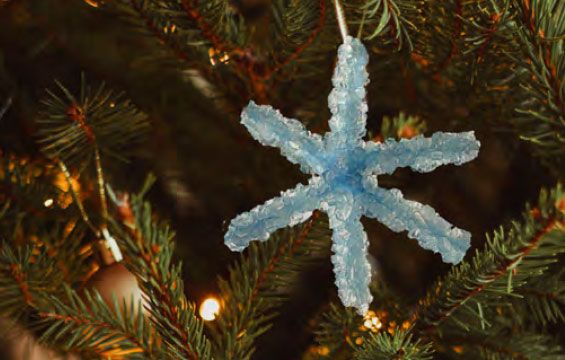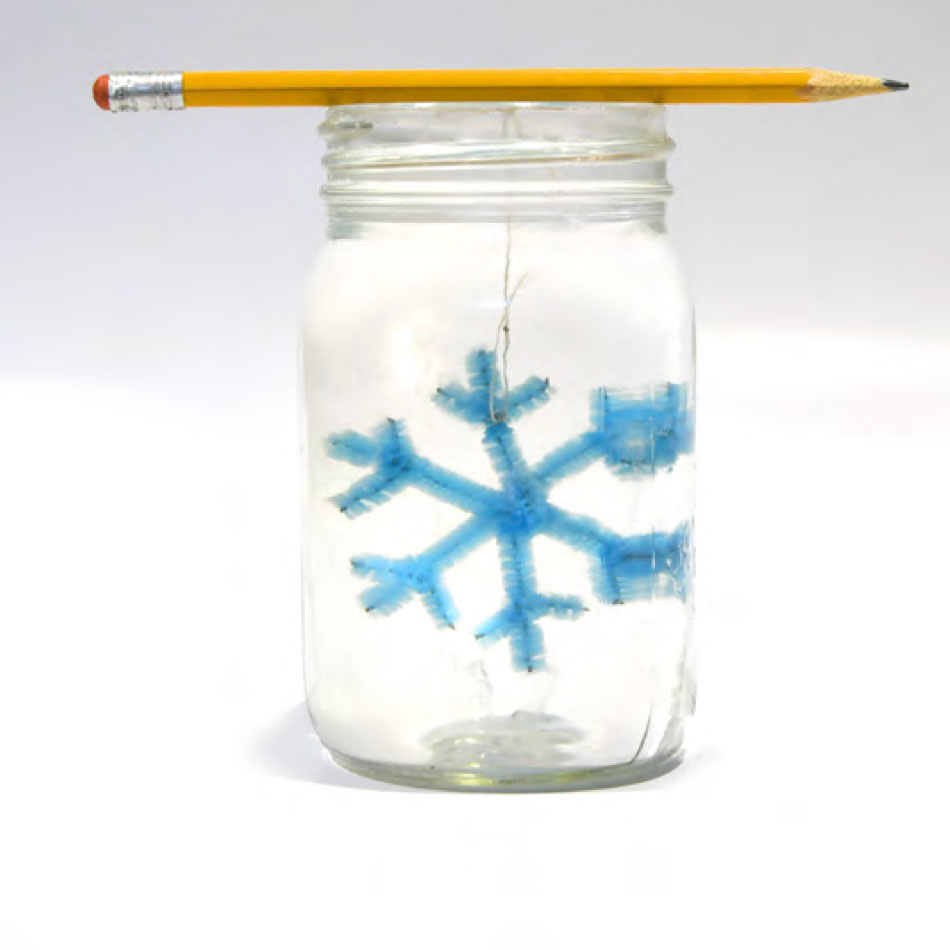Grow a Crystal Snowflake
Tap into chemistry to discover how snowflakes are formed
- All
- Things to Make
- Experiments

What you’ll need:
- Pipe cleaners
- Scissors
- String
- A pencil or pen
- A wide-mouth glass jar
- Tape
- A measuring cup
- Adult supervision
Ingredients:
- ¼ cup salt
- 1 cup of very hot water (from the tap or freshly boiled)

Activity setup:
- Cut a piece of pipe cleaner into three equal pieces. The length of the three pieces should be smaller than the width of your glass jar, as the pipe cleaner will need to fit inside the jar with some room to spare.
- Twist the pipe-cleaner pieces together at the centre, then spread them out evenly to create a snowflake with six arms.
- Cut another pipe cleaner into six equal pieces, then twist one small piece onto each snowflake arm in a V shape.
- Cut a piece of string to about the same length as your glass jar. A mason jar is a great option for this activity. Tie one end of the string to the centre of the snowflake and the other end to a pencil.
- Place the pencil across the top of the jar, letting the snowflake hang down inside the jar. Twist the pencil to wind the string around it until the snowflake is hanging without touching the bottom or sides of the jar. Then, tape the string in place.
- Pour 1 cup of very hot water into a heat-safe measuring cup. Ask a grownup for help with this step!
- Add half of the salt to the hot water and stir until it is completely dissolved.
- Slowly add the remaining salt, stirring as you go. When the salt won’t dissolve anymore and a few crystals have settled at the bottom of your cup, stop adding salt.
- Pour the salt water into your jar. Make sure the snowflake is submerged but not touching the bottom or sides of the jar.
- Store the jar in a safe location. Keep it in a spot where you can watch the crystals develop, but where the jar won’t accidentally be knocked over or disturbed.
- Now, it’s time to wait. It will take up to four days for the crystals on your snowflake to fully form. Look at the jar each day to observe any changes, but don’t move the jar.
- After four days, carefully remove your crystallized snowflake and hang it somewhere safe to dry.
- Hang your crystallized snowflake in your window as a winter decoration!

How does it work?
When you mixed the salt with the water, the molecules combined completely, creating a solution. The hot temperature of the water caused the salt to dissolve even more easily than usual. By adding salt until it couldn’t dissolve any more, you made a saturated solution.
When the hot water cooled, it contained more salt than water usually does at this temperature. As a result, the salt slowly began to precipitate. This means the salt began turning back into solid crystals. Over a few days, the tiny salt crystals grew on top of each other on your pipe cleaner to form a large set of visible crystals.
How do snowflakes form?
The salt crystals you see on your homemade snowflake are a collection of hundreds of smaller crystals. Similarly, real snowflakes are composed of many tiny water crystals arranged in a pattern. When the warm water vapour in a cloud comes into contact with cool air, it changes form, transforming from a gas into a liquid. To form a snowflake, these liquid droplets need to come into contact with a solid—just like the salt molecules attached to your pipe cleaner.
What solid material can be found in the sky? Dust! When the temperature is cold enough, water droplets that encounter a speck of dust transform from liquid to solid to form a water crystal. As this crystal falls through the cool air, more droplets attach to it and form new crystals. It takes a lot of droplets to form an average-sized snowflake: about 100,000 droplets, in fact! Because each crystal falls in its own particular path, every snowflake has its own unique pattern.
Experiment with different materials
Try using a different ingredient instead of table salt to create your crystallized snowflake. You can follow the same procedure using 1 cup of Epsom salt or 2 cups of sugar. How do the crystals differ from your salt snowflake? Compare how long it takes the crystals to form, and be sure to observe the shape and size of your crystals when you use different materials.
For speedier results, follow the same procedure as above using 3 tablespoons of Borax. You should notice lots of crystals after just one day!
Safety first! — Borax can irritate your skin, eyes and lungs, and it can be harmful if swallowed. Ask a grownup for help handling Borax, and don’t touch your snowflake once your crystals are complete.